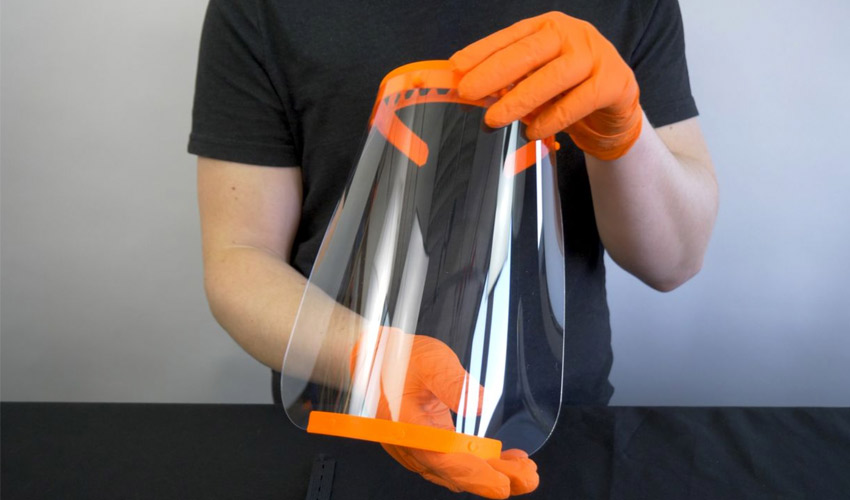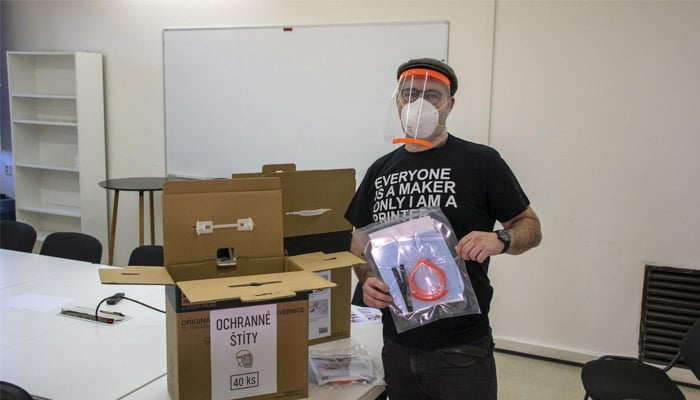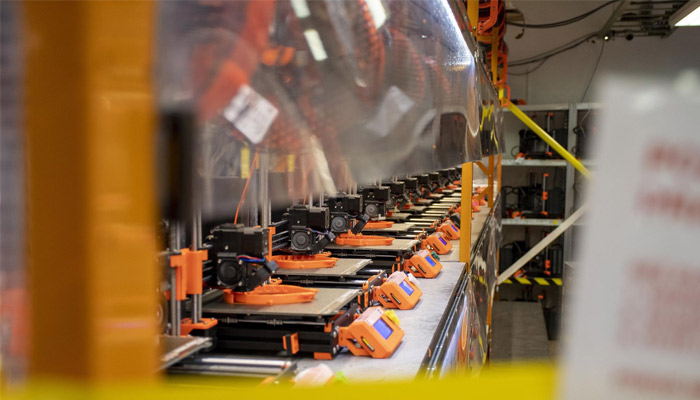Prusa mass produces medical shields to fight COVID-19

The open-source 3D printer manufacturer Prusa has shown its support by 3D printing hundreds of medical shields for medical staff. It joins the many players in the additive manufacturing industry who have launched various initiatives to combat COVID-19. The mask designed by Prusa is a 3D printed face shield, to be placed over a conventional surgical mask. It protects the eyes and blocks the spread of microbes and germs. In three days, the teams obtained dozens of prototypes, Prusa explained that the first units have just been sent to hospital for field tests and checks.
You may be familiar with the model of this protective mask. In fact, Prusa started from a file available on GrabCAD, which it then adapted for easier 3D printing. You may also have seen it on the Budmen Industries website, where the founding couple printed a few hundred of them in their cellar. Josef Prusa wanted to send an important message to his community: “I don’t intend to hamper the vibe we have now – not by a long shot, but printing respirators might not be the best idea at this time. Let me explain. None of the designs available right now have been tested to ensure they provide the protections needed, at least none of the ones I am aware of. To help with this, we have collected as many designs as we could find, and are working with experts to see if we can verify which ones really work. What are the key focus points? First, it’s the sealing, then the filter itself, the filter to the mask, and how the mask attaches to the face – it all must be perfect. Most of us print rigid materials that are hard to make compliant for seals. Even if we can get a good seal, will it remain functional e.g. even when the wearer talks?“

Josef Prusa wearing the 3D printed face shield
3D printed face shield: a safer option?
The teams therefore decided to create a solution that would protect the entire face, to be placed over a mask, thus avoiding any safety issues. Indeed, a 3D printed mask raises some questions: what about the resistance of the plastic as the wearer breathes, creating a humid and warm area, a breeding ground for germs? Healthcare professionals cannot take this risk. That’s why such a shield seems less restrictive at first glance.
Currently, the company explains that it can produce 800 parts per day thanks to its 3D printer farm, with only 1/5 of its capacity currently used for this particular project. The number of parts produced on a daily basis could therefore easily increase. Josef Prusa explains that the design of the safety mask is currently being verified and that it could evolve in the coming days or even hours. He provides valuable printing tips on his website to ensure the device is as safe as possible for both doctor and patient. For example, remember to ventilate the room in which you are going to print the mask, wear gloves and a surgical mask, don’t leave the piece on the heated 3D printing plate for too long, etc. Moreover, beware that “the virus can live on the plastic for 48-90 hours and plastics cannot be easily sterilized after use. So they are one-use only, at least until we find a way to reliably sterilize the printed parts!“

Prusa’s 3D Printer Farm prints hundreds of parts a day
What material do you need to produce the shield?
It takes about 2 hours to print the different parts that make up the face mask. The manufacturer recommends using PETG. Printing supports are not required. You will need a rubber band to attach both ends of the mask and a plastic sheet thick enough for the front – Prusa says that any clear laser-cut plastic will do: count at least 0.5 mm thick. Once you have the parts, you can follow the assembly steps in the video below:
The manufacturer reportedly donated its first 10,000 units to the Czech Ministry of Health. He invites individuals to print the mask for local communities in need, as long as they follow all the instructions online. Everything is available on the Prusa website HERE.
What do you think of these 3D printed medical shields? Let us know in a comment below or on our Facebook and Twitter pages! Don’t forget to sign up for our free weekly Newsletter, with all the latest news in 3D printing delivered straight to your inbox!







Bravo, très belle idée de la part de Prusa. Ça fait du bien au moral de voir que dans ces temps difficiles, certaines personnes pensent à autre chose que le profit.
Franck.
I want to make parts and equipment that are of value in this fight. I seriously doubt I am alone. Is there someone who has design files for parts for a working ventilator or anyone coordinating construction of a medically acceptable ventilator design that is coordinating an effort to have people build the parts and send for assembly? If not there really should be. I just joined and am looking into a facebook group which appears to be working on such a thing, but I can not find anything organized to the level of having all the part files available and a plan to actually assemble ventilators in mass yet.
UV light will sterilize the parts. But don’t trust me, look it up. I think a “black light” will do the trick.